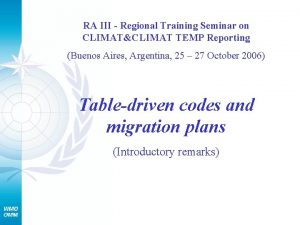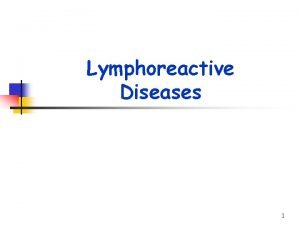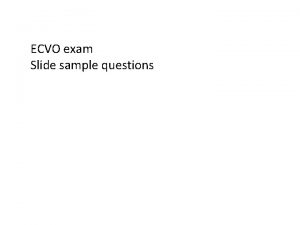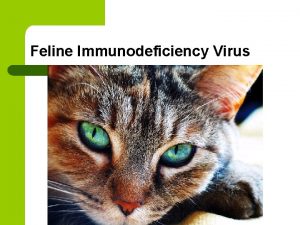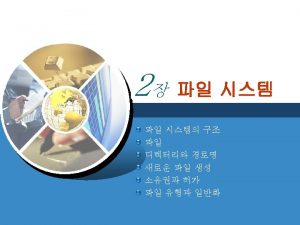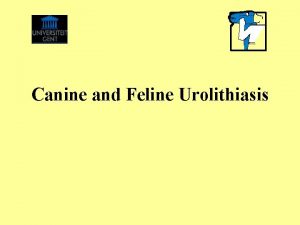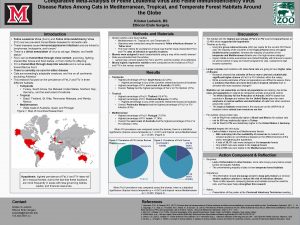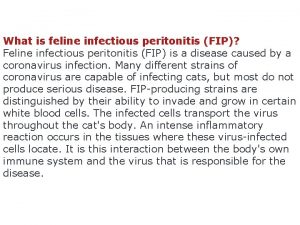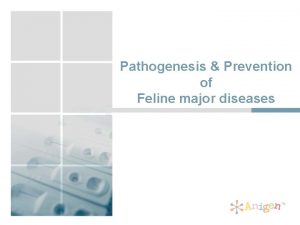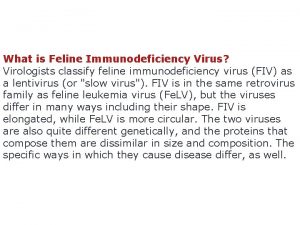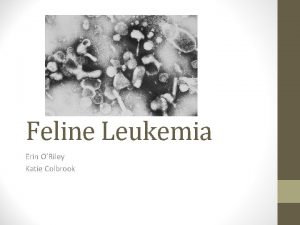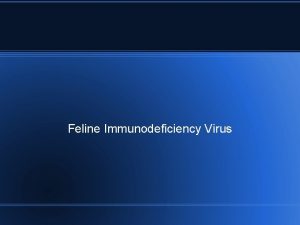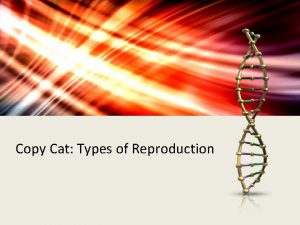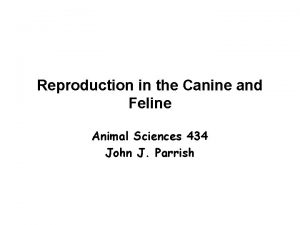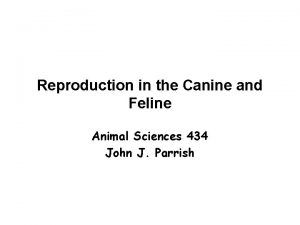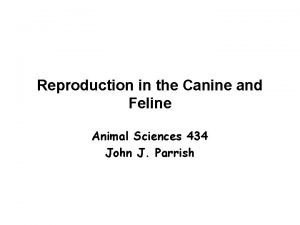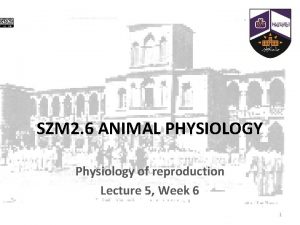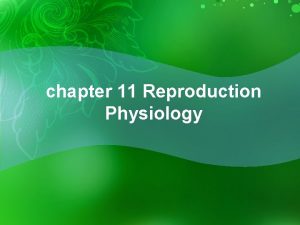Reproduction in the Cat Feline Physiology and Reproduction






















- Slides: 22

Reproduction in the Cat



Feline Physiology and Reproduction in the Queen Average of puberty in the queen: 10 months (range 4 -18). Queen is seasonally polyestrous breeder in that photoperiod controls the period of cyclicity. Breeding season: is from March to September. Actually split seasons with January to March and August to October. Queen is anestrous during late fall and winter. Household queens can cycle during winter with lights in house giving 12 to 14 hours of light.

Estrous Cycle of Queen Reproductive cycle in the queen is similar to other species with one unique difference. Queen requires copulation to stimulate ovulation. Average length of the estrous cycle is 14 to 21 days. Estrus will last approximately 7 days followed by a period of non-receptivity for 10 days if no mating occurs. Estrous Cycle Proestrus: Duration one day or less Characteristic: Rolling, head rubbing, vocalization, crouching often with rear quarters elevated, treading movement of feet but still rejecting male.

Estrus: Duration is 6 to 7 days. • Characteristic: Increase intensity of proestrus activity but will now accept male. Acceptance allows mating with deviation of tail to one side and permission of Tom to grasp her neck, mount and copulate Metestrus: Duration is 1 to 2 weeks • Characteristic: Following non-ovulation (no mating) there is no acceptance of male and loss of signs of heat. Psuedopregnancy: • Sterile mating induces ovulation of follicles and formation of CL release progesterone which is maintained for 35 -45 days


Reproductive Tract Oviduct Ovarian Bursa Ovary Bladder Uterine Horn Uterine Body Urethra Cerivx Vagina Vestibule Vulva Clitoris

Hormonal Changes during Estrous Cycle and Pregnancy Estradiol Progesterone Copulation LH Parturition Heat 10 Heat 20 30 0 10 Days 20 30 40 50 60 70

Mating of Queen induces LH surge for Ovulation • Mating by male induces ovulation but it takes approximately a minimum of 4 matings to induce ovulation in queen. • Male may breed 10 x/hour (WOW!!!) • The penial spines on the cranial end of the Tom’s penis induces the stimulation of the vagina for the LH surge to ovulate. Duration of Gestation in Queen: 63 -66 days Pregnancy Diagnosis: Abdominal Palpation: 20 -30 days

Termination of Pregnancy • Cabergoline was given orally (n=5; 50 µg/cat/day) for five consecutive days. • Prostaglandin F 2 was administered SC (n=5; 2. 5 mg/cat/day) for five consecutive days. • Both cabergoline (n=5; 50 µg/cat/day) and prostaglandin F 2. (2. 5 mg/cat/day) were administered. Ahmadzadeh et al, 2000

Anatomy of Tom Bulbourethral Gland Scrotum Kidney Rectum Testis Ureter Bladder Ductus Deferens Cornified Spines Glans Penis Prostate Gland Urethra Os Penis Glans Penis

Reproductive Anatomy of Tomcat Ductus Deferens Ureter Scrotum Glans Penis Urethra Prostate Gland Bladder

Average at: 9 months Semen Characteristics: Volume: 0. 04 ml Total Sperm 15 -130 x 106 Motility 60 -95%

Breeding and Mating Behavior Cats are nocturnal • Female in heat crouches, rolls stamps hind feet and raises pelvis • Male detects female through pheromones • Female bends tail to one side and male bites back of neck to insert penis. • When penis is withdrawn, female will move forward and give out the “copulation cry”. • The copulation cry is thought to be caused by the penial spines as the penis is withdrawn. • Breeding is repeated several times

Breeding and Mating Behavior

Ovary in Bursa Ovarina Bursa Follilcles Oviduct Opening to Bursa Ovary Uterine Horn

Scrotum and Penis Scrotum Note opening to penis in the tomcat is below scrotum

Scrotum and Testis Caput Epididymis Testis Corpus Epididymis Scrotum

Penis and Pelvic Region Glans Penis Bulbourethral Gland Ductus Deferens Bladder Urethra Penis Crus Penis Prostate Gland

Testis Ductus Deferens Corpus Epididymis Pampiniform Plexus Caput Epididymis Testis Cauda Epididymis

Penis and Accessory Glands Glans Penial Spines Penis Bulbourethral Gland Crus Penis Prostate Gland Urethra
 Cat 1 cat 2 cat 3 aviation
Cat 1 cat 2 cat 3 aviation Cat 3 ils
Cat 3 ils Human skull with restored features from jericho
Human skull with restored features from jericho Cardiopet probnp feline 1,500
Cardiopet probnp feline 1,500 Famous new york street candy bar
Famous new york street candy bar Native american burial grounds candy
Native american burial grounds candy Heart disease cat
Heart disease cat Lymphoid
Lymphoid Ecvo test
Ecvo test Hare lynx
Hare lynx I bought me a cat and the cat pleased me
I bought me a cat and the cat pleased me Sexual and asexual reproduction venn diagram
Sexual and asexual reproduction venn diagram Sexual vs asexual reproduction venn diagram
Sexual vs asexual reproduction venn diagram Hình ảnh bộ gõ cơ thể búng tay
Hình ảnh bộ gõ cơ thể búng tay Bổ thể
Bổ thể Tỉ lệ cơ thể trẻ em
Tỉ lệ cơ thể trẻ em Voi kéo gỗ như thế nào
Voi kéo gỗ như thế nào Tư thế worms-breton
Tư thế worms-breton Chúa yêu trần thế alleluia
Chúa yêu trần thế alleluia Môn thể thao bắt đầu bằng chữ f
Môn thể thao bắt đầu bằng chữ f Thế nào là hệ số cao nhất
Thế nào là hệ số cao nhất Các châu lục và đại dương trên thế giới
Các châu lục và đại dương trên thế giới
